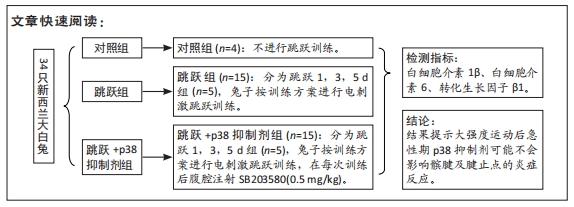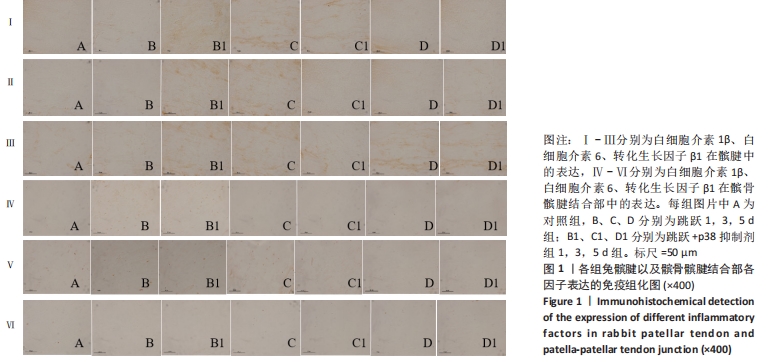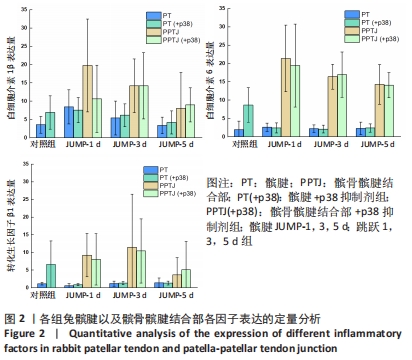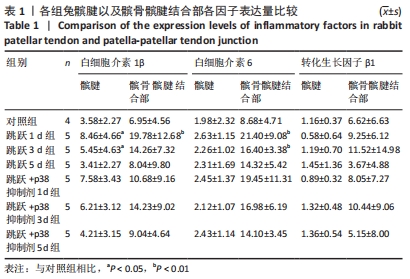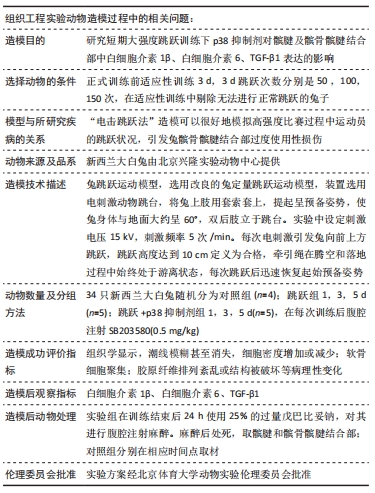[1] SCHMID MR, HODLER J, CATHREIN P, et al. Is impingement the cause of jumper’s knee? Dynamic and static magnetic resonance imaging of patellar tendinitis in an open-configuration system. Am J Sports Med. 2002;30(3):388-395.
[2] KHAN KM, COOK JL, KANNUS P, et al. Time To Abandon The “Tendinitis” Myth: Painful, Overuse Tendon Conditions Have A Non-Inflammatory Pathology. Br Med J. 2002;324(7338):626-627.
[3] 梁孝天.抗炎干预对兔髌腱及止点结构及细胞因子变化的影响[D].北京:北京体育大学,2017.
[4] 陈晓蓝,梁孝天,张宁,等.腱止点过度使用性损伤形成过程中细胞外基质的调节机制[J]. 中国组织工程研究,2020,24(20):3174-3179.
[5] 刘春雨,韩小燕.离心训练治疗髌腱末端病的系统评价[J].中国康复医学杂志,2016,31(1):71-76.
[6] 曾晓辉.积极性恢复对兔骨腱结合部过度使用性损伤愈合的影响[D].北京:北京体育大学,2014.
[7] 袁建敏,陶周善,杨民,等.带线锚钉联合髌骨横向钻孔修复股四头肌腱骨腱结合部断裂[J].中国骨伤,2020,33(1):71-75.
[8] 王琳.髌骨骨腱结合部损伤延迟愈合模型建立及冲击波治疗效果的研究[D].北京:北京体育大学,2007.
[9] 顾新丰,周义钦,郑昱新,等.炎症在肌腱病中的作用研究进展[J].国际骨科学杂志,2020,41(6):356-360.
[10] 汤婷婷,王国祥.应力刺激下p38MAPK信号通路在软骨损伤中的作用[J].中国运动医学杂志,2015,34(2):208-212.
[11] 谢文鹏,徐龙进,王象鹏,等.p38 MAPK信号通路在膝关节骨性关节炎中医药诊疗中的作用[J].中国实验方剂学杂志,2019,25(8): 219-225.
[12] YU L, HÉBERT MC, ZHANG YE. TGF-beta receptor-activated p38 MAP kinase mediates Smad-independent TGF-beta responses. EMBO J. 2002;21(14):3749-3759.
[13] Bernet JD, Doles JD, Hall JK, et al. p38 MAPK signaling underlies a cell-autonomous loss of stem cell self-renewal in skeletal muscle of aged mice. Nature Med. 2014;20(3):265-271.
[14] 宫凤艳. 维拉帕米通过TGF-β1/smad3/P38/ERK1/2信号通路缓解大鼠跟腱损伤修复后的纤维化粘连[D].长春:吉林大学,2019.
[15] 张频捷,朱立新,耿小平,等.p38 MAPK信号传导通路及其抑制剂的研究现状[J]. 安徽医药,2010,14(5):596-598.
[16] 于波,朱振安.骨关节炎治疗靶点p38MAPK信号通路研究进展[J].国际骨科学杂志,2011,32(6):6-8.
[17] 方小芳.火针对跟腱末端病大鼠组织中IL-1β、IL-6及iNOS影响的研究[D]. 北京:首都体育学院,2010.
[18] 乔芳,郭璞,刘相莲,等.microRNA与炎症因子之间调控的研究进展[J].生理科学进展,2018,49(2):120-124.
[19] 康玉华.基于炎症因子及TGF-β1/Smad2信号通路探讨加减三甲散对大鼠肝纤维化分子机制的影响[D].成都:成都中医药大学, 2016.
[20] PAPANICOLAOU P , CHRYSOMALI E , STYLOGIANNI E, et al. Increased TNF-α, IL-6 and decreased IL-1β immunohistochemical expression by the stromal spindle-shaped cells in the central giant cell granuloma of the jaws. Med Oral Patol Oral Cir Bucal. 2012;17(1):e56-62.
[21] MENDIAS CL, GUMUCIO JP, LYNCH EB. Mechanical loading and TGF-β change the expression of multiple miRNAs in tendon fibroblasts. J Appl Physiol. 2012;113(1):56-62.
[22] 黎炜英,朱卫雄,刘丹,等.bFGF、TGF-β联合使用对大鼠骨骼肌卫星细胞增殖能力的影响[J]. 武汉大学学报(医学版),2007,28(6): 733-736.
[23] 陈方旭,米焱,王彩丽,等.TGF-β/Smad、p38MAPK及JNK/SAPK信号通路在糖尿病肾病发生发展中作用机制的研究进展[J].山东医药,2019,59(9):106-109.
[24] 李霄,王彩霞,李敬宇,等.p38丝裂原活化蛋白激酶通路在神经病理性疼痛形成机制中的研究进展[J]. 中华疼痛学杂志,2021,17(1): 103-109.
[25] 梁丽,马佳韵,申海霁,等.p38抑制剂对激素抵抗型哮喘患者肺泡巨噬细胞炎性因子的作用[J].临床肺科杂志,2019,24(1):22-26.
[26] 赵田芋,晋松.髌韧带末端病运动疗法的研究进展[J].中国康复医学杂志,2021,36(2):241-245.
[27] 侯捷,李文彦,刘瑞瑞,等.髌腱末端病致病风险因素及治疗方式的研究进展[A]. 中国体育科学学会运动生物力学分会.第二十一届全国运动生物力学学术交流大会论文摘要汇编[C].中国体育科学学会运动生物力学分会:中国体育科学学会,2021.
[28] 刘欢,丁其瑞,马成,等.两种小鼠膝关节骨软骨损伤模型制备方法比较研究[J].中国修复重建外科杂志,2021,35(7):862-867.
[29] 刘海涛.跳跃负荷致髌骨髌腱结合部和髌腱纤维化机制及冷水浴干预影响[D].北京:北京体育大学,2017.
[30] 扈盛,欧高志,滕宇,等.末端病造模方法的研究[J]. 武汉体育学院学报,2006,40(4):79-81.
[31] 宋晓君,王琳.电击跳跃法建立动物模型的研究进展[J].福建体育科技,2013,32(4):28-30.
[32] Van der Worp H, de Poel HJ, Diercks RL, et al. Jumper’s knee or lander’s knee? A systematic review of the relation between jump biomechanics and patellar tendinopathy. Int J Sports Med. 2014;35(8): 714-722.
[33] 刘波.电针治疗腱末端病的生物力学研究-Ⅰ电针对末端结构断裂特性的影响[J]. 中国中医骨伤科杂志,1995,3(5):9-13.
[34] 江大雷.髌骨髌腱结合部跳跃损伤动物模型建立及运动后冷疗对损伤的影响[D].北京:北京体育大学,2016.
[35] THORPE CT,CHAUDHRY S,LEI II, et al. Tendon overload results in alterations in cell shape and increased markers of inflammation and matrix degradation. Scand J Med Sci Sports. 2015;25(4):e381-391.
[36] WANG L, GAO W, XIONG K, et al. The effects of an early return to training on the bone-tendon junction post-acute micro-injury healing. J Sports Sci Med. 2012;11(2):238-244.
[37] SCHWARTZ AJ, SARVER DC, SUGG KB, et al. p38 MAPK signaling in postnatal tendon growth and remodeling. PLoS One. 2017;10(3): 0120044.
[38] DAVIES MR, LIU X, LEE L, et al. TGF-β Small Molecule Inhibitor SB431542 Reduces Rotator Cuff Muscle Fibrosis and Fatty Infiltration By Promoting Fibro/Adipogenic Progenitor Apoptosis. PLOS One. 2016; 11(5):0155486.
[39] 秦理,杨孝兵,刘丽敏,等.艾拉莫德联合MAPK通路抑制剂对类风湿关节炎大鼠的治疗作用[J]. 浙江医学,2020,42(19):59-63.
[40] 董莹,韩金玉,孙姗,等.p38丝裂原活化蛋白激酶信号通路在炎性痛大鼠吗啡耐受形成中的作用[J].神经解剖学杂志,2020,36(5):65-69. |
